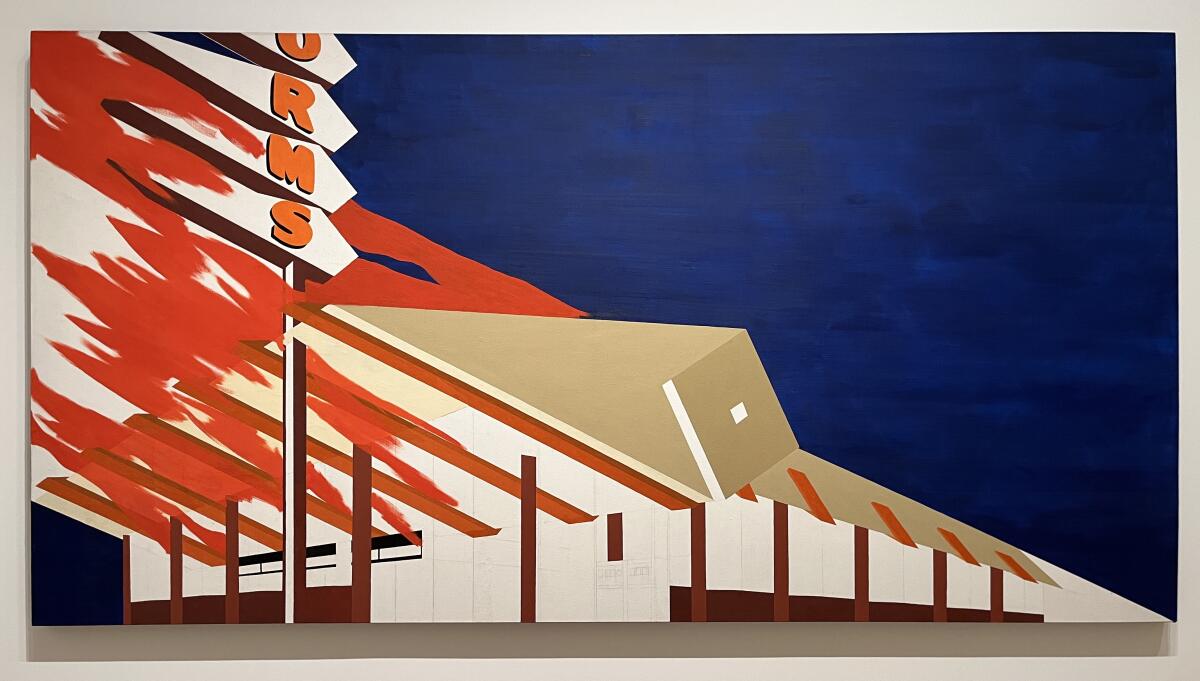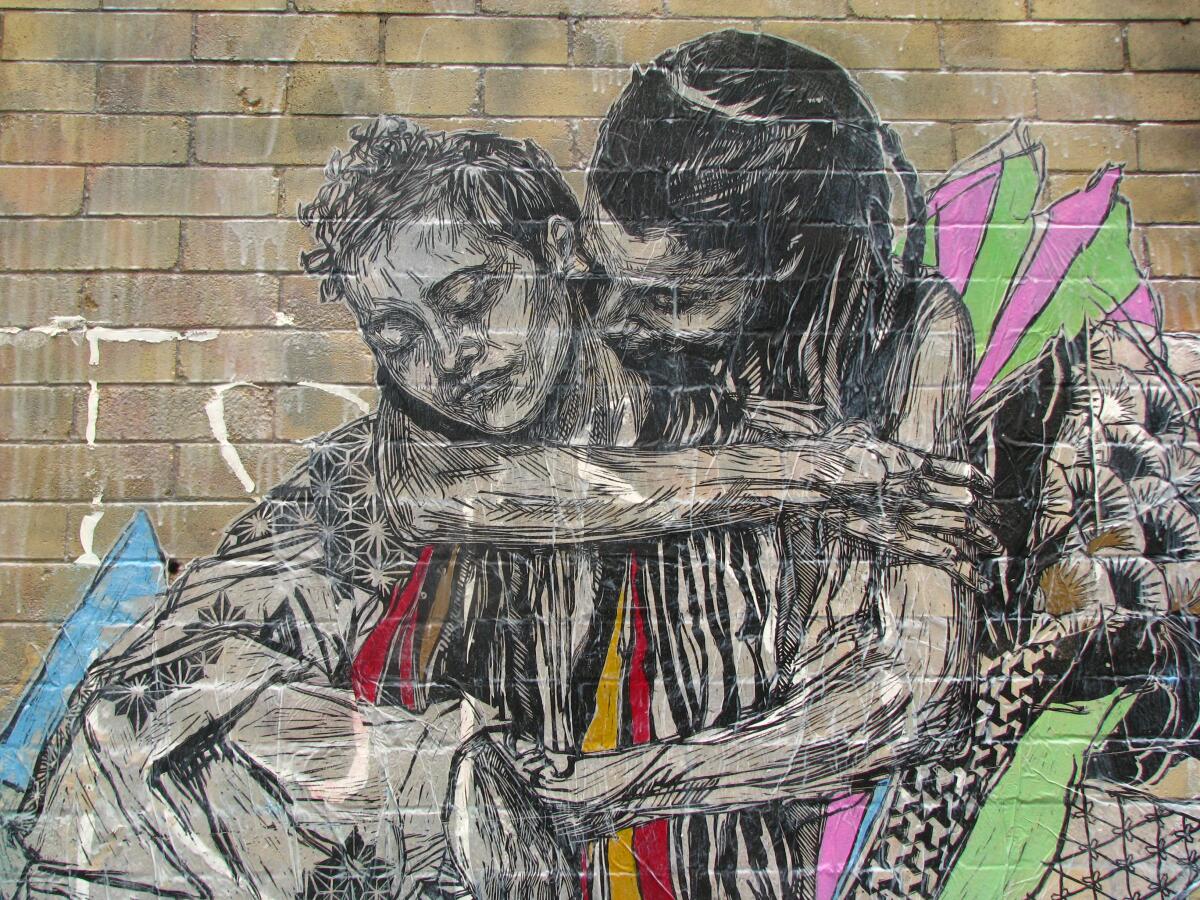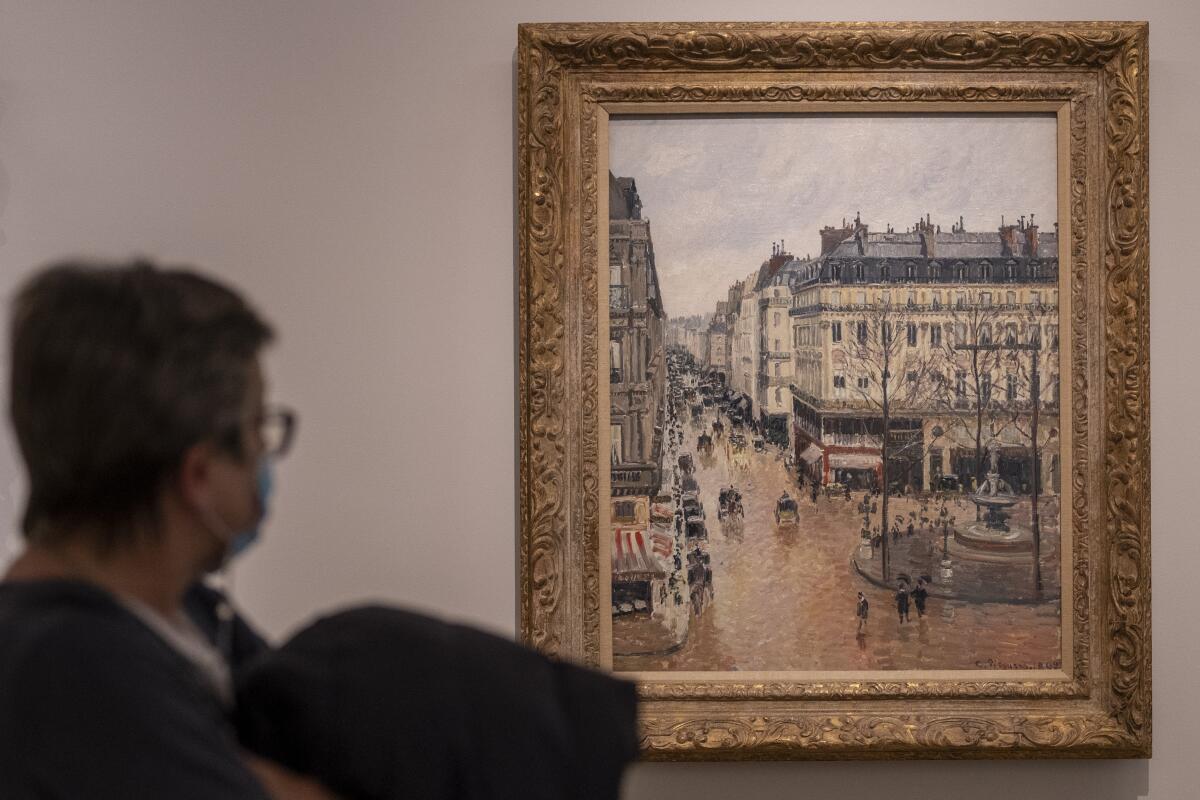AI is making mincemeat out of art (not to mention intellectual property)

- Share via
It is chilly in California, so I warm myself with the remaining embers of civilization. I’m Carolina A. Miranda, art and design columnist at the Los Angeles Times, and I’m here with some Goth moodiness and essential arts news:
Tech won’t save us
Thomas Kinkade is on the list. So is Thomas Hart Benton. Pop pioneer Ed Ruscha, currently the subject of a MoMA retrospective, makes an appearance, as does legendary New York graffitist TAKI 183. The list I’m talking about, which has been circulating since late last year, features the names of more than 16,000 artists — and it was allegedly used by developers at Midjourney to help refine its generative AI program. (So that users can command Midjourney to do things like “create a landscape in the style of Ed Ruscha.”) It appears to be a longer version of a list appended to a class-action lawsuit filed last year against Midjourney and similar companies — DeviantArt, Stability AI and Runway AI — for copyright infringement.
The list has created a stir among artists, who are learning that their copyrighted works are being used to train programs to mimic their style without their consent.
Theo Belci at the Art Newspaper has a good explainer on the list and the lawsuit. (The 453-page complaint is worth a gander, alleging that the scale of “misappropriation” is “staggering and unprecedented.”) This parallels a lawsuit filed late last year by the New York Times against OpenAI and Microsoft, the creators of ChatGPT. “Defendants seek to free-ride on The Times’s massive investment in its journalism,” that complaint states, in order to “ create products that substitute for The Times and steal audiences away from it.”
There are other lawsuits, and Los Angeles Times tech columnist Brian Merchant digs into them, looking at how AI companies are fighting copyright holders in direct and insidious ways. “The user is left vulnerable too — there’s nothing in the output that says what the sources are,” cognitive scientist and AI expert Gary Marcus tells Merchant. “In fact the software isn’t capable of doing that in a reliable way. So the users are on the hook and have no clue as to whether it’s infringing or not.”

Whether the list being circulated is the list used by Midjourney is almost beside the point. The larger issue is that tech companies scrape the work of artists and writers to their benefit without consent or compensation, turning anyone who has ever had the audacity to post anything to the internet — including a 6-year-old — into grist for their mill. The Atlantic recently published a tool that allowed authors to see whether their books had been used to train generative AI models. It was a thoroughly disheartening exercise given that most authors earn a pittance, while OpenAI has a valuation of $100 billion.
The larger question is: What is the purpose of this?
You’re reading Essential Arts
Make the most of L.A. with our guide to events and happenings in the SoCal arts scene. In your inbox twice a week.
You may occasionally receive promotional content from the Los Angeles Times.
Elaine Velie and Rhea Nayyar at Hyperallergic recently covered the case of an online user employing generative AI to “complete” a 1989 work by Keith Haring titled “Unfinished Painting.” The piece features Haring’s trademark line figures occupying a corner of a canvas, the rest of which remains bare — except for a few streaks of dripping paint. “Unfinished Painting” was a meditation on AIDS — Haring died of AIDS-related complications in 1990 — and was featured in the exhibition, “Keith Haring: Art Is for Everybody,” at the Broad museum last year.
Feeding Haring’s work into an AI that will then be deployed to misconstrue Haring’s intention feels like an ouroboros of idiocy. It’s also a distressing taste of what the world of art made by AI might be like: a not-quite-right regurgitation of everything that came before.
Whether the pending lawsuits can put reins on AI remains to be seen. Legislation might be more helpful, but some members of Congress are too busy sharing nude photos of Hunter Biden to focus on how AI might upend livelihoods and intellectual property.
“It’s up to workers everywhere to see this for what it is, get organized, educate lawmakers and fight to get paid fairly for their labor,” William Fitzgerald, a former member of Google’s public policy team, tells Merchant. “Because if they don’t, Google and OpenAI will continue to profit from other people’s labor and content for a long time to come.”
In the meantime, artists are turning to tech to save them from tech. ARTnews recently had a story about all the digital tools artists can use to protect their work from scraping.
In and out of the galleries
In a surprising (and downright puzzling) decision, a U.S. appellate court rejected a plea by the descendants of Lilly Cassirer to have a Nazi-looted painting held by a Spanish museum returned to them. The painting in question is Camille Pissarro’s late 19th century street scene, “Rue Saint-Honoré in the Afternoon. Effect of Rain”; the museum is the Thyssen-Bornemisza in Madrid. Times legal affairs reporter Kevin Rector has a thorough piece on the decision, which hinges on a combination of U.S. and Spanish law as well as the chain of custody of the painting.

Walker Mimms reviews the revived Luna Luna installation in the New York Times. And he is dismayed by the cost — and the tiered entry fees.
Plus, Greg Allen has a look at Luna Luna’s Boyle Heights location: A few minutes’ walk from the old 356 Mission, a site of much anti-gentrification protest.
Just dance
Artist Rashaad Newsome has a new film on view at ArtCenter’s Mullin Gallery in Pasadena that features a nonbinary humanoid named Being the Digital Griot, whose movements are inspired by Black vernacular dance and forms of nonverbal communication shared by Black people in the U.S. “That’s really germane to the Black American experience,” Newsome tells Times staff writer Steven Vargas, “because Black folks came to this country, and we couldn’t bring anything, so we had to create what is Black and subsequently Black culture.”

Latin dancing is generally based on a traditional setup involving a male “lead” and a female “follow.” De Los contributor Eva Recinos has a look at how new dance organizations and competitions are changing that. As L.A.-based dancer Bex Nitti, who founded a Latin dance team called Queerchata, says: “Am I performing for folks to see, or do I get to move how I want to move in this space?”
Books
A man is found dead in his Long Beach apartment. A hive mind relays the events that follow. I took a detour into the Books section this week to profile Compton-raised author Venita Blackburn, who is about to debut her terrific first novel, “Dead in Long Beach, California.” As Blackburn tells me: “The book is not about healing. It’s not about getting to the end of grief. It’s not about offering solutions. It’s about the particular feeling, the hard crack of disaster in a family — and not getting any answers.”

The fallout from Gaza
Arts institutions continue to reckon with the Israel-Hamas War. The Eskenazi Museum of Art at Indiana University at Bloomington (IU) canceled a retrospective by Palestinian abstract artist Samia Halaby — who is also an IU alum — over “safety concerns.” Elaine Velie at Hyperallergic reports that more than 1,300 people have signed a petition urging IU to reinstate the show. “Clearly the intent is to suppress Palestinian voices at this very time,” Halaby tells Velie. “If that were not their intention why not accept my offer to meet with them and clear matters? Why did they not speak up during the three long years of preparation?”
Enjoying this newsletter? Consider subscribing to the Los Angeles Times
Your support helps us deliver the news that matters most. Become a subscriber.
Hundreds have signed a document circulated by a group called Strike Germany, which calls on artists not to mount exhibitions in German institutions that “police the politics of their artists” — in particular those who have made statements in support of Palestinians. Among the signatories are Turner Prize-winning artists Lawrence Abu Hamdan, Charlotte Prodger and Tai Shani, as well as Nobel Prize-winning writer Annie Ernaux. ARTnews’s Alex Greenberger has more details.
Looking and listening
Films and television series set in space often have a rather chilly aesthetic: metallic spaceships, dark blue skies, characters in practical uniforms. Which is why I’ve been seduced by the look of the animated series “Scavengers Reign,” which landed on Max late last year. The show revolves around the human survivors of a crash on a strange planet called Vesta. I’ve been struck by how its creators — Joseph Bennett and Charles Huettner — have imagined this incredible world: in luscious reds, pinks and purples, with pulsating ecosystems that bear unusual creatures and vegetation.
Andrew Webster at the Verge sees in this imaginary planet the influence of French comic artist Jean “Moebius” Giraud, creator of Arzach, a ‘70s character known for riding a pterodactyl over psychedelic landscapes. “It’s equal parts beautiful and strange,” writes Webster of “Scavengers Reign,” “and it might be the most original piece of science fiction this year.”
Over at the New York Times, TV critic James Poniewozik is struck by the show’s visuals but also its psychology. “The series is more entrancing than horror-show scary,” he writes. “It is attuned to its characters’ loneliness, fear and remorse, and there is a strain of psychedelic spirituality in its rendering of the surreal ecosystem.”
Absorbing, weird, visually stunning — I’m six episodes in and ready for much more.
Hat tip to Our Opinions Are Correct for turning me on to the show. You can watch it here.

Unrelated but also very cosmic: I’m digging this downloadable lunar calendar from artist Christina Ondrus.
Moves
The Imperial County Board of Supervisors has designated Leonard Knight’s “Salvation Mountain” a Historically Significant Property and Historic Resource.
Los Angeles Contemporary Exhibitions announced the recipients of its latest Lightning Fund Artist Grant, who include Jisoo Chung, Jerri Allyn and Nery Gabriel Lemus, as well as the inaugural winner of the Jacki Apple Award for Performance and Artist Projects, which goes to L.A.-based performance artist Marcus Kuiland-Nazario.
The Andy Warhol Foundation this week awarded $4 million in organizational grants to 50 arts organizations and museums around the U.S. In L.A., recipients include LAXART, JOAN, the Hammer Museum and Semiotext(e).
Oregon’s Portland Art Museum has appointed Lloyd DeWitt curator of European and American Art pre-1930, a newly created position..
Giselle Byrd has been named director of the Boston-based Theater Offensive, becoming the first Black trans woman to lead a regional theater company in the U.S.
Passages
Critic Joan Acocella, whose essays on dance for the New Yorker and the New York Review of Books touched on everything from George Balanchine to the TV series “Dancing With the Stars,” is dead at 78.
Ofelia Valdez-Yeager, a Riverside arts patron who championed the creation of the Cheech Marin Center for Chicano Art and Culture, has died at the age of 76. Her legacy, Marin tells De Los staff writer Alejandro Molina, “is one of respect and purpose.”

Giovanni Anselmo, an artist connected to the arte povera movement who turned granite into a gravity-defying material, is dead at 89.
Françoise Bornet, the young woman depicted in photographer Robert Doisneau’s iconic ‘50s-era image of a Parisian couple kissing, has died at 93.
Composer Alice Parker, who created arrangements of traditional hymns, as well as operas, oratorios and song cycles — one inspired by the sermons of Martin Luther King Jr. — is dead at 98.
In the news
— Art patron Les Wexner‘s name has materialized in a trove of recently unsealed documents in the Jeffrey Epstein sex-trafficking case.
— Vittorio Sgarbi, the controversial art critic who recently became Italy’s undersecretary for culture, has been indicted in connection with the alleged theft of a work by 17th century painter Rutilio Manetti; Sgarbi denies the accusation.
— As Silvio Berlusconi‘s heirs try to figure out what to do with his art hoard, Louisa McKenzie at the Times of London looks at political leaders who were assiduous collectors. (I’m totally here for the bit about Andy Warhol tooling around Iran in the ‘70s trying to whip up commissions from the family of the Shah.)
— Gillian Anderson‘s Golden Globes gown, by Gabriella Hearst, was embroidered with dozens of vulvas.
— A good story on the last days of Berkeley’s People’s Park.
— Globe and Mail architecture critic Alex Bozikovic is digging OMA’s redo of the Buffalo AKG Art Museum, previously known as the Albright Knox.
— The Art Newspaper caught up with gallerist, “Patron Satan” and California candidate for the U.S. Senate Stefan Simchowitz.
— Important Tinned Fish Update: After much conferring (OK, Slacking), my editor Boris Kachka and I concur that Island Creek’s Mussels in Pickled Sauce are a mighty fine victual. Hats off to Tim Marchman’s Popping Tins newsletter for the rec.
And last but not least ...
Marina Abramović has a skincare line. I’m waiting for the Vito Acconci hand lotion.
The biggest entertainment stories
Get our big stories about Hollywood, film, television, music, arts, culture and more right in your inbox as soon as they publish.
You may occasionally receive promotional content from the Los Angeles Times.




